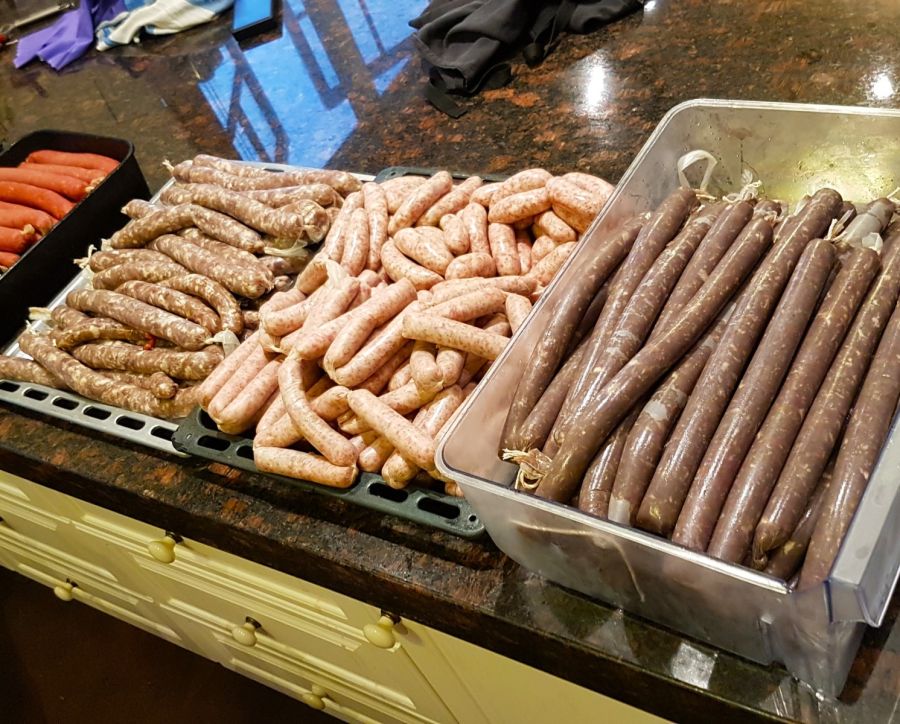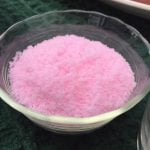I’ve been studying, teaching, and making sausages for decades. Salt is always included in every recipe. I’ve also used many different types of salts for sausage, which I’ll elaborate on.
Sauages can be defined into three broad categories first being cured and dried.
Second, fresh raw meat is then grilled or poached to finish (ie. Bratwurst).
Lastly, a ready-to-eat sausage – hot smoked or cooked as part of the recipe and process (Hot Dog – which is emulsified a sub-category).
A dry-cured (hard) salami needs a higher salt level for curing and preserving.
The last two categories, which are cooked sausages, (here is a massive list of cooked sausages) need less salt since salt is desired for its seasoning/taste level.
I will go into detail below about the types of salt for sausage, in summary, the types to use for all sausage making whether raw or dry cured sausage/salami are Pure Sea Salt -fine, Kosher, Pickling, or Canning Salt
Salt Amount Depends on Type of Sausage
Let me give you a general rule of thumb for those not interested in accuracy, and then I’ll explain why you will sometimes have variations using volume as a basis, e.g., a tablespoon or teaspoon.

For a fresh sausage or ready-to-eat sausage, it’s about seasoning
One tablespoon per 1000 grams / 2.2 pounds of meat
For a dry-cured hard salami sausage, a minimum cure amount is needed
One and a Half tablespoons per 1000 grams / 2.2 pounds of meat
(this would include pink curing salt; this is another subject matter in regard to curing and salami making)
To explain this in detail, I’ve provided tables and further information below.
Salt Sausage Amounts
Sausage making is as much an art as it is a science.
One of the key ingredients that can make or break your sausage is salt.
The right salt balance is crucial for flavor, texture, and safety.
For a Fresh Sausage to be Cooked Or a Hot Smoked Sausage
Specifically, this is about grilling sausages, such as bratwurst or hot dogs. The type of sausage that needs cooking. In Italy, this raw type of sausage is often heavily salt seasoned, since it used for stews, casseroles and other dishes to increase the base flavor.
Salt as a Ratio to the Total Weight of the Meat
| Salt % to Meat | Total Meat (grams) | Total Meat (pounds) | Salt (grams) | Salt (ounces) | Salt *tbsp 15g |
|---|---|---|---|---|---|
| Minimum (1%) | 1000g | 2.2lbs | 10 g | 0.35oz | ⅔ – 1 tbsp |
| Common (1.5%) | 1000g | 2.2lbs | 15 g | 0.53oz | 1 – 1⅔ tbsp |
| Maximum (3%) | 1000g | 2.2lbs | 30 g | 1.06oz | 2 – 3½ tbsp |
For a Dry Cured Salami or Salami, that will not be cooked, but cured, and dried over time. Another range applies below.
Salt Amounts for Dry-Cured (Hard) Salami
| Salt % to Meat | Total Meat (grams) | Total Meat (pounds) | Salt (grams) | Salt (oz) | Salt *tbsp 15g |
|---|---|---|---|---|---|
| Minimum (2%) | 1000g | 2.2lbs | 20g | 0.71oz | 1⅓ tbsp |
| Common (2.25%) | 1000g | 2.2lbs | 22.5g | 0.79oz | 1½ tbsp |
| Maximum (4%) | 1000g | 2.2 lbs | 40g | 1.41oz | 2⅔ tbsp |
For the dozens of recipes I regularly make of raw sausage, 1.5% is the amount of salt I use. For hard dry cured salami (article I wrote about dry cured salami making), 2.25% is the amount I use.
Many of those who make salami also use these amounts from my research into the matter.
I’ve tasted salami in various Southern, Central, Eastern, and Western European countries. Certain cultures have a very high tolerance to salt, 4-5% in some cases. I’ve found this nearly unedible. Everyone does perceive taste differently, though.
Saltiness in Sausage Perception
Saltiness is subjective, varying from person to person. While some may prefer a saltier taste, others may find it overpowering.
Understanding your taste preferences and those of your audience is key to achieving the perfect level of saltiness in your sausage.
It took ten years of experimentation to find the salt seasoning I preferred for sausages and salami (differences I wrote about).
Different Salts and Different Volume Amounts
Not all salts are created equal, which also holds true for their volume equivalents.
Different salts have different densities, meaning that a teaspoon of one salt may not weigh the same as another. Understanding these differences is essential to ensure accurate seasoning in your sausage recipes.
Pretty important if a recipe calls for “one tablespoon of salt”- dinner might be over salted with fine sea particles, and under salted with Kosher flakes. Of course, if recipes used weight instead of volume measures, there wouldn’t be a problem. One ounce of salt is one ounce of salt atoms, no matter how many tablespoons it takes to measure out that ounce.
Geninue Ideas
Types of Salt: Differences and How They Affect Your Sausage
| Salt Type | Suitability for Sausage Making | Comments |
|---|---|---|
| Coarse Sea Salt | Unsuitable | Too concentrated, doesn’t spread evenly in ground meat |
| Table Salt | Suitable for Raw Sausage Making | Check for additives such as anticaking agents or iodine |
| Finishing Salt | Not Recommended | Cost-inefficient, lightly structured, not ideal for universal distribution of salt in sausage making |
| Kosher Salt | Suitable for All Types of Sausage Making | No added agents, texture between coarse and table salt, appropriate for sausage and curing |
| Pickling & Canning Salt | Suitable for All Types of Sausage Making | Maybe Suitable, Potentially inconsistent |
| Himalayan Pink Salt | Maybe Suitable, Potential inconsistent | Contains minerals, may vary in mineral content between batches |
For a visual look at various salts, I found this article useful.
Categories:
- Coarse
- Kosher
- Fine (Pickling, Canning)
- Finishing/Flaky
These are the main categories of salt.
Coarse salts or large chunks are unsuited for sausage making since the goal is to universally spread the salt throughout the meat. Coarse rock salt will be too concentrated in the ground meat.
Sea Salt – Coarse
It would also fall into this category of being too concentrated.
Table Salt
Fine sea salt is suitable for raw sausage making. Table salt sometimes contains agents used for anticaking or added iodine, which can have an unwanted adverse effect on cured meats.
Finishing Salt
Often in a more crystal form or flaky.
This lightly structured, it could be used for sausage, but is cost inefficient. Not recommended.
Kosher Salt / Pickling Salt
Due to Jewish beliefs, no added agents are used in processing. Kosher salt works for sausage. Its texture is between coarse and table salt. It’s suitable for all types of sausage and curing.
Pickling salt is the same without Jewish Belief certification.
Pickling & Canning Salt
No agents or additives also finer/smaller than kosher salt. Appropriate for sausage-making.
Himalayan Pink Salt
In rock or fine grinds, below is the chunky rock type.

It contains mainly minerals—I’ve used it successfully for meat curing and sausaging. However, from batch to batch, it may also contain unwanted minerals.
Not to be confused to pink curing salt, which is nearly flourscent pink.

Measuring Salt – Tips
When it comes to measuring salt for sausage making, precision is key. Here are some tips to ensure you get it just right every time:
- Use a kitchen scale for the most accurate measurements.
- If using volume measurements, fluff up your salt before scooping.
- Consider the density of the salt you’re using and adjust your measurements accordingly.
Volume Isn’t Accurate Vs. Weight
While volume measurements are common in many recipes, they can be notoriously inaccurate regarding salt.
This is because salt’s density can vary widely depending on factors such as grain size and moisture content. Using weight measurements with a pocket scale (accuracy to 0.1 grams or 1 decimal place)is far more reliable for achieving consistent results in sausage-making endeavors.
By understanding the nuances of salt sausage ratio ranges and adopting precise measurement techniques, you’ll be well-equipped to create perfectly seasoned sausages every time. Happy sausage making!

Tom Mueller
For decades, immersed in studying, working, learning, and teaching the craft of meat curing, sharing the passion and showcasing the world of charcuterie and smoked meat. Read More
